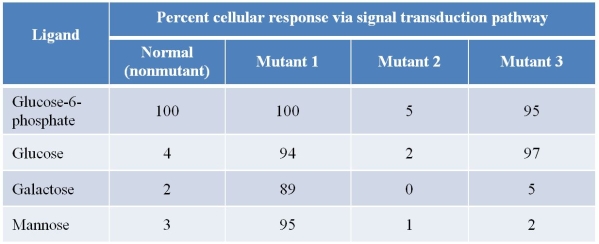Multiple Choice
Refer to the table below.  The table summarizes results of experiments using a group of normal cells and three other groups of the same type of cells, each carrying a different mutation in a membrane receptor protein.The receptor is part of a signal transduction pathway that is stimulated by glucose-6-phosphate.Cells were tested for their ability to respond, via the signal transduction pathway, to a variety of ligand molecule, as shown in the table.Based on these data, which statement about these three mutations is plausible?
The table summarizes results of experiments using a group of normal cells and three other groups of the same type of cells, each carrying a different mutation in a membrane receptor protein.The receptor is part of a signal transduction pathway that is stimulated by glucose-6-phosphate.Cells were tested for their ability to respond, via the signal transduction pathway, to a variety of ligand molecule, as shown in the table.Based on these data, which statement about these three mutations is plausible?
A) Mutations 1, 2, and 3 each broaden the specificity of ligand binding in different ways.
B) Mutations 1 and 3 broaden the specificity of ligand binding, while mutation 2 eliminates ligand binding.
C) Mutation 1 broadens the specificity of ligand binding, while mutations 2 and 3 eliminate ligand binding.
D) Mutation 3 has no effect on ligand binding, while mutations 1 and 2 have dramatic effects on ligand binding.
E) Mutations 1 and 3 have no effect on ligand binding, while mutation 2 has a dramatic effect on ligand binding.
Correct Answer:

Verified
Correct Answer:
Verified
Q2: A transcription factor located in the cytoplasm
Q3: Adrenocorticotropic hormone (ACTH) is a peptide consisting
Q4: Refer to the figure below. <img src="https://d2lvgg3v3hfg70.cloudfront.net/TB5650/.jpg"
Q5: Refer to the table below. <img src="https://d2lvgg3v3hfg70.cloudfront.net/TB5650/.jpg"
Q6: The hydrolysis of phosphatidyl inositol-bisphosphate (PIP<sub>2</sub>) results
Q8: In which aspect are gap junctions and
Q9: Which structure makes up part of a
Q10: Neighboring animal cells can communicate directly through
Q11: Signals that travel to distant cells through
Q12: Refer to the figure below, which represents